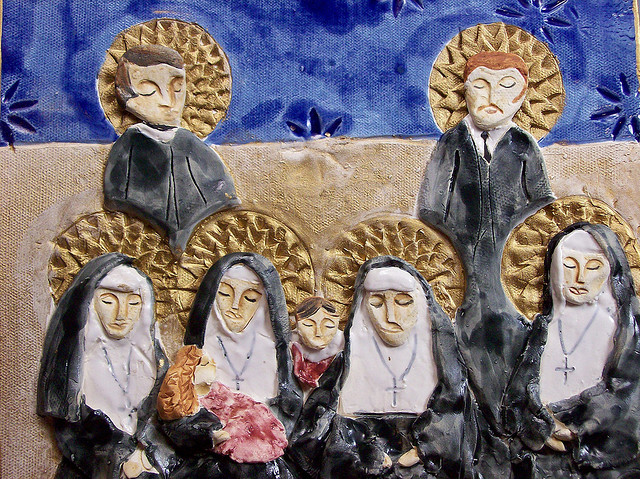Constance and her companions
Last week I was reading about Constance and Her Companions. One of the fabulous things about the Internet is how much information used to be obscure, hard to find, or just existing in a single copy in a library somewhere is now no more than a quick search engine click away.
In this case it was a compilation of writings by the sisters that were gathered an annotated by an unknown person just a year after the epidemic that killed all but one them.
It is a long document, but worth reading. When I read it, one short sentence leapt out at me. From August 29, 1878, sandwiched in between notes about the number of new cases of fever that day and a note that four ‘romish’ priests were dead was the line: “One cares so much for the lovely weather, the evening light; one sees such exquisite pictures everywhere. It seems almost heartless to care for them!
That line made me stop and think about how easy it is to fall into the idea that I should feel a certain way in some circumstances. That I should be solemn at a funeral, sad at the bedside of a dying friend, and happy at the birth of a child when frequently my feelings are much more complex and unpredictable.
When my son was born I did feel so much joy that I started crying, but at the same time I felt terror, exhaustion, and straight up crankiness. At my father-in-law’s funeral I was distracted between feeling his loss, a tendency to giggle at odd things, and distracted anxiety that my son (then around four) wouldn’t sit still at the right times and it would be my fault.*
I never had just one type of feeling during those times when I had a cultural expectation of what I was ‘supposed to feel’ and when I saw the line from Sister Constance’s papers quoted above it brought me up short. Here she was in the midst of suffering and death and she could still see beauty and feel it move her. She felt ‘almost heartless’ but I think it was a gift from God and it reminded me of another story.
My housemate’s family were in the displaced persons (DP) camps in Europe at the end of World War II. They were in the camps for a long time and lived with a great deal of uncertainty about what would happen to them. In spite of that, the adults got together and set up schools for the children and classes for the adults. The adult classes were places where skilled artisans could teach others their trades including leather and metal working. Using scraps and sharing what little they had, they learned to make art from one another. In the midst of confusion and doubt they banded together to keep each other’s spirits up and minds engaged in the world around them, until, at last they made it out of Europe to the United States. My housemate has a few of the things that her grandfather made in the camps and even without the context of where and when they were made, they are beautiful.
I think the trait to see beauty even in the midst of death and destruction, the ability to make beauty out of nearly nothing, and to raise others up into beauty makes us both fully human and in touch with the divine.
So Sister Constance was not heartless in her recognition of beauty, she was touched by creation in the best possible way.
*Disclaimer: all of the fear of being judged by my in-laws came from my own insecurities and never from them, but it took me about 15 years to figure that out.
Resources used:
“The Sisters of St. Mary at Memphis: With the Acts and Sufferings of the Priests and Others Who Were There with Them during the Yellow Fever Season of 1878.” The Sisters of St. Mary at Memphis. Ed. Unknown. Project Canterbury, n.d. Web. 16 Sept. 2015. <http://anglicanhistory.org/usa/csm/memphis1.html>.
Kristin Fontaine is an itinerant Episcopalian, crafter, hobbyist, and unstoppable organizer of everything. She spends a lot of time thinking about the meaning of life and her relationship to God and it all spills out in the essays she writes. She recently embarked on a new adventure with her husband, supporting him as he launches Dailey Data Group, a statistical consulting company.

